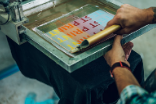My Experience With Exposure Screen Printing – When exposing a screen, exposure time varies depending on the type of light, whether there is reflector, distance from the screen, bulb wattage, etc. And if you don’t expose a screen long enough, the image gets washed away. If you expose a screen too long, you will start to lose fine detail of the image.
Before you expose real work, you want to run a test to find the best exposure time. First take the light you have, and place it above a frame. You want to place it high enough that the whole screen gets equally exposed, but not so high that the screens will take forever to expose. If you use a spot light, it might focus too much light on the center of the screen, and not as much on the corners. This would lead to uneven exposure.
Once you have the light and placement figured out, we need to figure out some rough times. In the Speedball manual they give some times for a 150W clear incandescent bulb:
Screen size, bulb height, exposure time
– 8×10, 12 inches, 45 minutes
– 10×14, 12 inches, 45 minutes
– 12×18, 15 inches, 74 minutes
– 16×20, 17 inches, 92 minutes
– 18×20, 17 inches, 92 minutes
The higher the bulb is above the screen, the longer it needs to be exposed. If the wattage of the bulb is lower, you need to exposure it longer.
- When I used the 75 watt incandescent bulb at 17 inches, I had to adjust the time. Since the wattage was half of the 150 watt recommended bulb, I simply doubled the exposure time. This worked fine.
- When I started using a 250 watt halogen light at 23 inches, I needed to refigure the exposure time. Since the 250 watt halogen light was brighter than a 150 watt incandescent light. A halogen bulb puts out more light than an equivalent wattage incadescent bulb. So the exposure time would need to drop. And since I was raising the light higher above the screen, the exposure time would need to increase.
So not knowing the best time for exposure, I had to experiment. I didn’t want to expose screen after screen until I got it right.
This is what I did:
I coated a screen the usual way. I printed a transparency with numbers from 10 to 90 in increments of 5. With the light set up, I placed the screen under the light to be exposed. I had a stop watch going. After 5 minutes, I covered the 5 with an opaque piece of paper. After 10 minutes, I also covered the 10. I did this until all of the numbers were covered. Then I washed out the screen. The lowest numbers that were distinctly printed gave me the correct exposure time. The numbers below 40 all got washed away. 50 looked okay, but 60 looked better. So I used 60 minutes as an exposure time for my 250 watt halogen light (without UV filter glass) at 23 inches. With experience, I have since lowered the exposure time to 45-50 minutes.
That’s an article about My Experience With Exposure Screen Printing. Hope you enjoy.

